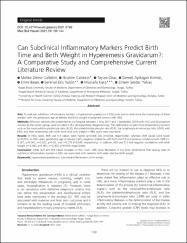| dc.contributor.author | Çaltekin, Melike Demir | |
| dc.contributor.author | Çaltekin, İbrahim | |
| dc.contributor.author | Onat, Taylan | |
| dc.contributor.author | ... | |
| dc.contributor.author | Yalçın, Serenat Eris | |
| dc.contributor.author | Kara, Mustafa | |
| dc.contributor.author | Yalvaç, Ethem Serdar | |
| dc.date.accessioned | 2025-02-06T06:48:47Z | |
| dc.date.available | 2025-02-06T06:48:47Z | |
| dc.date.issued | 2021 | en_US |
| dc.identifier.citation | Caltekin, M., Caltekin, I., Onat, T., Kirmizi, D., BAŞER, E., Yalcin, S., ... & YALVAÇ, E. (2021). Can Subclinical Inflammatory Markers Predict Birth Time and Birth Weight in Hyperemesis Gravidarum?: A Comparative Study and Comprehensive Current Literature Review. HASEKI TIP BULTENI-MEDICAL BULLETIN OF HASEKI, 59(2). | en_US |
| dc.identifier.issn | 13020072 | |
| dc.identifier.uri | https://10.4274/haseki.galenos.2021.6799 | |
| dc.identifier.uri | https://hdl.handle.net/20.500.12513/7066 | |
| dc.description.abstract | Aim: To evaluate subclinical inflammatory markers in hyperemesis gravidarum (HEG) cases and to determine the relationship of these markers with the gestational age at delivery and birth weight in pregnant women with HEG. Methods: Fifty-two patients who presented to our hospital between 1 May 2017 and 1 September 2019 with HEG and 60 pregnant women as the control group were included in this retrospectively designed study. The relationship of subclinical inflammatory markers such as the neutrophil-to-lymphocyte ratio (NLR), the platelet-to-lymphocyte ratio (PLR), the lymphocyte-to-monocyte ratio (LMR) with HEG, and their relationship with birth week and birth weight in HEG cases were examined. Results: In HEG cases, NLR and PLR values were higher (p=0.006 and p=0.004, respectively), whereas LMR values were lower (p<0.001). In HEG cases, gestational age at delivery had a negative correlation with NLR and PLR and positive correlation with LMR (r=-0.567, p<0.001; r=-0.322, p=0.02, and r=0.279 p=0.045, respectively). In addition, NLR and PLR had negative correlations with birth weight (r=-0.582, p<0.001; r=-0.302, p=0.029, respectively). Conclusion: While NLR and PLR values increase in HEG cases, LMR value decreases. It has been determined that varying rates of subclinical inflammatory markers in HEG are associated with preterm birth week and low birth weight. © 2021 by The Medical Bulletin of İstanbul Haseki Training and Research Hospital The Medical Bulletin of Haseki published by Galenos Yayınevi. | en_US |
| dc.language.iso | eng | en_US |
| dc.publisher | Galenos | en_US |
| dc.relation.isversionof | 10.4274/haseki.galenos.2021.6799 | en_US |
| dc.rights | info:eu-repo/semantics/openAccess | en_US |
| dc.subject | Birth Weight | en_US |
| dc.subject | Hyperemesis Gravidarum | en_US |
| dc.subject | Subclinical Inflammation | en_US |
| dc.title | Can Subclinical İnflammatory Markers Predict Birth Time and Birth Weight in Hyperemesis Gravidarum?: A Comparative Study and Comprehensive Current Literature Review | en_US |
| dc.type | article | en_US |
| dc.relation.journal | Haseki Tip Bulteni | en_US |
| dc.contributor.department | Tıp Fakültesi | en_US |
| dc.contributor.authorID | Mustafa Kara / 0000-0003-2282-6850 | en_US |
| dc.identifier.volume | 59 | en_US |
| dc.identifier.issue | 2 | en_US |
| dc.identifier.startpage | 139 | en_US |
| dc.identifier.endpage | 144 | en_US |
| dc.relation.publicationcategory | Makale - Uluslararası Hakemli Dergi - Kurum Öğretim Elemanı | en_US |


















